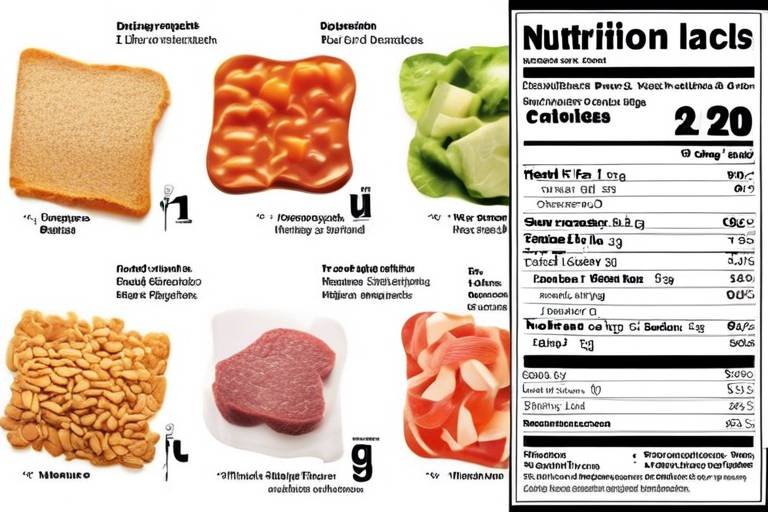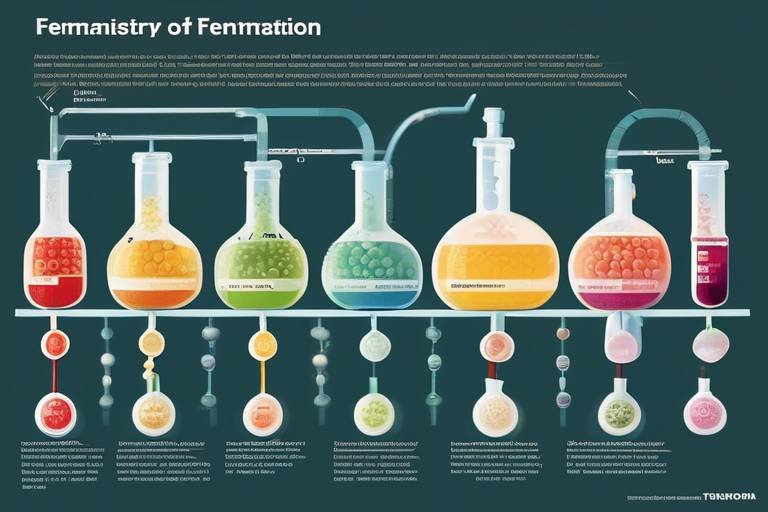The Chemistry of Cleaning Products - What’s Really in Them?
Have you ever wondered what makes your favorite cleaning products so effective? It's not just magic; it's chemistry! Cleaning products are a blend of various chemical compounds designed to tackle dirt, stains, and germs. Understanding their composition can help you make informed choices about what you bring into your home. This article dives deep into the chemical makeup of these products, exploring how they work and what impacts they might have on both our health and the environment.
At the core of many cleaning solutions are surfactants, which play a crucial role in breaking down grime. These compounds lower the surface tension of water, allowing it to spread more easily and penetrate dirt. Imagine trying to wash a greasy pan with just plain water; it wouldn’t be very effective, right? Surfactants are like tiny superheroes that help water do its job better. They surround dirt particles, lifting them off surfaces and allowing them to be rinsed away.
But surfactants are just one piece of the puzzle. Many cleaning products also contain enzymes, which are biological catalysts that speed up chemical reactions. Enzymes can break down complex stains that traditional cleaners struggle with, such as food spills or blood stains. Think of them as tiny workers tirelessly breaking down tough messes so that you don’t have to scrub as hard. This article will explore the fascinating world of enzymes and how they contribute to effective cleaning.
As we delve deeper into the chemistry of cleaning products, we’ll also touch on fragrances. While they make our homes smell fresh, they can also have hidden consequences for our health. Are you aware that some fragrances can trigger allergies or sensitivities in certain individuals? This leads us to a critical discussion about ingredient transparency and the importance of knowing what’s in the products we use every day.
Join us as we uncover the science behind cleaning products, their effectiveness, and the potential risks associated with their use. By the end of this article, you’ll not only understand what’s really in your cleaners but also how to choose the safest and most effective options for your home.
- What are surfactants? Surfactants are compounds that reduce surface tension in liquids, helping them to spread and penetrate surfaces more effectively.
- How do enzymes work in cleaning products? Enzymes act as catalysts that break down specific types of stains, making them easier to remove.
- Are synthetic fragrances safe? While many synthetic fragrances are considered safe, they can cause allergic reactions in some individuals, so it's essential to check ingredient labels.
- What should I look for in a cleaning product? Look for products with clear ingredient lists, preferably those that use natural ingredients and have minimal synthetic chemicals.

Understanding Surfactants
When it comes to cleaning products, one of the unsung heroes in the mix is a group of compounds known as surfactants. These powerful agents play a crucial role in the way our favorite cleaners work, and understanding them can help us appreciate the science behind the sparkle. But what exactly are surfactants? In simple terms, they are molecules that have a unique structure, featuring a hydrophobic (water-repelling) tail and a hydrophilic (water-attracting) head. This dual nature allows surfactants to reduce surface tension in liquids, making it easier for water to spread and penetrate surfaces to lift away dirt and grime.
Imagine trying to wash a greasy pan with plain water; it would be an uphill battle! Surfactants come to the rescue by breaking the bond between the grease and the pan, allowing the water to wash it away more effectively. This is why they are commonly used in various cleaning products, from laundry detergents to dish soaps and surface cleaners. In fact, surfactants can be categorized into four main types based on their charge:
- Anionic Surfactants: These are negatively charged and are particularly effective at removing dirt and organic matter. They are commonly found in laundry detergents and all-purpose cleaners.
- Cationic Surfactants: These positively charged surfactants are often used in fabric softeners and disinfectants, as they can help to eliminate bacteria and provide a pleasant scent.
- Nonionic Surfactants: These surfactants have no charge and are less sensitive to water hardness. They work well in a variety of cleaning products and are often found in dishwashing liquids.
- Amphoteric Surfactants: These can act as either anionic or cationic depending on the pH of the solution. They are gentle and often used in personal care products.
Surfactants are not just about making cleaning easier; they also enhance the overall effectiveness of cleaning products. By allowing water to spread more evenly across surfaces, they help to lift and suspend dirt particles, making it easier for them to be rinsed away. However, it’s important to note that not all surfactants are created equal. Some may have adverse effects on the environment and human health, raising concerns about their long-term use. This leads us to consider the balance between effective cleaning and safety.
In summary, surfactants are vital ingredients in many cleaning products, acting as the bridge between water and dirt. Their ability to lower surface tension and improve cleaning efficiency makes them indispensable in our everyday lives. However, as consumers, being aware of the types of surfactants in the products we use can help us make informed choices about our cleaning routines and their impact on our health and the environment.

The Role of Enzymes
When it comes to cleaning, enzymes play a crucial role that often goes unnoticed. These biological catalysts are not just a fancy addition to your cleaning products; they are the unsung heroes that help break down stains and organic matter with impressive efficiency. Imagine trying to scrub a stubborn stain off your shirt. You might use elbow grease, but what if there was a tiny helper working on a molecular level to dissolve that stain? That’s the magic of enzymes!
Enzymes work by speeding up chemical reactions, specifically those that break down complex molecules into simpler, more manageable ones. For instance, when you spill a glass of red wine on your favorite tablecloth, enzymes in a cleaning solution can target the pigments and break them down, making it easier for the rest of the cleaner to wash them away. This is not just a theoretical concept; it's a practical application that has transformed the way we tackle stains in our everyday lives.
But how do these enzymes actually function in cleaning products? Well, they are designed to target specific types of stains. Think of them as specialized workers in a factory, each one trained to handle a particular task. This specialization is what makes them so effective. For example, some enzymes are great at breaking down proteins, while others excel at tackling fats or carbohydrates. The versatility of enzymes means that they can be formulated to address a wide variety of cleaning challenges.
Let’s dive a little deeper into the types of enzymes commonly found in cleaning products. Understanding these can help you choose the right product for your needs:
- Proteases: These enzymes target protein-based stains such as blood, egg, or dairy products. They are often found in laundry detergents, allowing you to effectively remove food and bodily stains without resorting to harsh chemicals.
- Lipases: If you've ever battled greasy stains from cooking, lipases are your best friends. These enzymes specifically target fats and oils, making them ideal for kitchen cleaning products. They break down greasy residues, ensuring your surfaces are spotless.
- Amylases: These enzymes focus on carbohydrates, breaking down starches and sugars. They can be particularly useful in cleaning up spills from sugary drinks or starchy foods.
Each type of enzyme serves a unique purpose, and their combined action in a cleaning product can significantly enhance its overall effectiveness. However, it’s important to note that the stability of these enzymes can be influenced by various factors, such as temperature and pH levels. For instance, high temperatures might denature some enzymes, rendering them ineffective. Therefore, understanding the conditions under which these enzymes thrive is essential for maximizing their cleaning power.
The effectiveness of enzymes in cleaning products hinges on their stability. If you think of enzymes as delicate instruments in a symphony, they need the right conditions to perform beautifully. Factors like temperature, pH, and even the presence of certain chemicals can impact their activity. For example, most enzymes function optimally at specific pH levels—too acidic or too alkaline, and they may lose their cleaning prowess.
In conclusion, enzymes are not just an added bonus in cleaning products; they are fundamental to their effectiveness. By breaking down stains at a molecular level, they allow us to clean more efficiently and with less effort. So, the next time you reach for a cleaner, remember that those tiny enzymes are working hard behind the scenes to make your life a little easier!
Q: What are enzymes in cleaning products?
A: Enzymes in cleaning products are biological catalysts that help break down stains and organic matter, making cleaning more effective.
Q: How do enzymes work?
A: Enzymes speed up chemical reactions that break down complex molecules, allowing for easier removal of stains.
Q: Are all enzymes the same?
A: No, different enzymes target different types of stains, such as proteins, fats, or carbohydrates.
Q: Do enzymes lose their effectiveness over time?
A: Yes, enzymes can lose effectiveness if exposed to extreme temperatures or unsuitable pH levels.
Q: Are enzyme-based cleaners safe for the environment?
A: Generally, enzyme-based cleaners are considered safer for the environment compared to traditional chemical cleaners, but it's always good to check the product's ingredients.

Types of Enzymes
When it comes to cleaning products, enzymes play a pivotal role in tackling various stains and dirt. These biological catalysts are not a one-size-fits-all solution; instead, they are specialized tools designed to target specific types of stains. Understanding the different types of enzymes can help you choose the right cleaning product for your needs. Let’s dive into the fascinating world of enzymes and explore how they work their magic in your home.
Enzymes can be categorized based on the type of stain they are most effective against. Here are the primary categories:
- Proteases: These enzymes are specifically designed to break down protein-based stains. Think about those pesky grass stains on your kids’ clothes or the food stains that seem to cling to your favorite shirt. Proteases are the unsung heroes in laundry detergents, effectively breaking down proteins found in food and bodily fluids.
- Lipases: If you’ve ever struggled with greasy messes in the kitchen, lipases are your best friend. These enzymes target fats and oils, making them essential for cleaning products designed for kitchen surfaces. They work by breaking down the lipid molecules, allowing for easier removal of greasy residues.
- Amylases: These enzymes focus on carbohydrates, particularly starches. They are particularly useful in products aimed at removing food stains, like those sticky spots left behind by pasta or rice. Amylases break down starches into simpler sugars, making it easier for cleaning agents to lift them away.
Each type of enzyme has its unique mechanism of action, and they often work best in combination with one another. For example, a laundry detergent that contains both proteases and lipases can effectively tackle a wider range of stains, from food spills to oil stains. This synergistic effect enhances the overall cleaning power of the product, making it more effective than if it contained only one type of enzyme.
Moreover, the effectiveness of these enzymes can be influenced by various factors, such as temperature and pH levels. For instance, proteases tend to work best in slightly alkaline conditions, while lipases may require a higher temperature to maximize their activity. This is why many cleaning products are formulated to optimize these conditions, ensuring that the enzymes can perform at their best.
In summary, understanding the types of enzymes in cleaning products can empower you to make informed choices when selecting cleaners for your home. Whether you’re dealing with food stains, grease, or dirt, there’s likely an enzyme specifically designed to tackle that challenge. So, the next time you reach for a cleaning product, take a moment to consider the science behind it and how these tiny catalysts are working hard to keep your spaces clean and fresh.
Q: Are enzymes safe to use in cleaning products?
A: Yes, enzymes are generally safe and effective in cleaning products. They are biodegradable and help reduce the need for harsh chemicals.
Q: Can enzymes work on all types of stains?
A: No, different enzymes target specific types of stains, such as proteins, fats, or carbohydrates. It’s important to choose the right enzyme for the stain you’re dealing with.
Q: Do enzyme cleaners require special care when using?
A: While enzyme cleaners are user-friendly, it’s essential to follow the instructions on the label for optimal results. Factors like temperature and pH can affect their performance.

Proteases
Proteases are fascinating enzymes that play a pivotal role in the effectiveness of many laundry detergents. They are specifically designed to target and break down protein-based stains, which are some of the most common types of stains we encounter in our daily lives. Think about it: whether it's a spaghetti sauce mishap on your favorite shirt or a grass stain from an afternoon of play, these protein stains can be stubborn and challenging to remove. That's where proteases come into play, acting like tiny biological scissors that cut through the proteins, making them easier to wash away.
These enzymes work by hydrolyzing the peptide bonds that link amino acids together in proteins. When you toss your clothes into the washing machine, the proteases spring into action, breaking down the proteins into smaller, more manageable pieces. This process not only helps in removing the stains but also prevents them from redepositing onto the fabric during the wash cycle. It's like having a personal stain-fighting army working tirelessly to keep your clothes looking fresh and clean.
In terms of application, proteases are particularly effective in laundry detergents because they function well in a range of temperatures and pH levels. This versatility means that they can be effective in both cold and hot washes, which is essential for energy savings and environmental considerations. Many modern detergents are formulated to include proteases that are stable at various conditions, ensuring that you get the best cleaning performance regardless of how you wash your clothes.
Interestingly, the effectiveness of proteases can also be influenced by other factors, such as the presence of surfactants and the overall formulation of the detergent. Surfactants help to lift stains from the fabric, while proteases tackle the stain at a molecular level. Together, they create a powerful cleaning synergy that can tackle even the toughest stains. This is why many leading laundry brands highlight the inclusion of proteases in their products as a selling point—it's a testament to their ability to provide superior cleaning power.
To give you a clearer picture, here’s a simple table summarizing the key characteristics of proteases:
| Characteristic | Description |
|---|---|
| Type of Stains | Protein-based stains (e.g., food, bodily fluids) |
| Function | Breaks down proteins into smaller peptides and amino acids |
| Temperature Range | Effective in both cold and hot water |
| pH Levels | Stable across a range of pH levels |
| Synergy with Surfactants | Enhances overall cleaning effectiveness when combined with surfactants |
In conclusion, proteases are a vital ingredient in the fight against tough stains in laundry detergents. Their ability to break down protein-based stains efficiently makes them indispensable for anyone looking to keep their clothes clean and fresh. Next time you do laundry, remember the unsung heroes working behind the scenes—these tiny enzymes that help restore your garments to their former glory!
- What are proteases? Proteases are enzymes that break down protein-based stains in laundry detergents.
- How do proteases work? They hydrolyze peptide bonds in proteins, making stains easier to wash away.
- Are proteases effective in cold water? Yes, many proteases are formulated to work effectively in both cold and hot washes.
- Can proteases damage fabrics? No, when used as directed, proteases are safe for most fabrics and enhance cleaning without causing damage.

Lipases
Lipases are fascinating enzymes that play a crucial role in tackling one of the most stubborn types of stains: fat and grease. Imagine trying to clean a greasy frying pan after cooking your favorite meal. Without the right tools, it can feel like an uphill battle. That’s where lipases come in, acting as powerful allies in our quest for cleanliness. These enzymes are specifically designed to break down lipids, which are the molecules responsible for oily stains. By targeting these fats, lipases make it significantly easier for cleaning products to lift away grime and restore surfaces to their original sheen.
In kitchen cleaning products, lipases are particularly valuable. They work by hydrolyzing triglycerides—fats and oils that are commonly found in food residues. When you spray a kitchen cleaner containing lipases, they immediately start breaking down these stubborn greasy molecules into smaller, more manageable components. This action not only enhances the cleaning power of the product but also reduces the amount of scrubbing you have to do. It's almost like having a miniature army of cleaning soldiers right at your fingertips!
To illustrate the effectiveness of lipases, consider the following table, which highlights their action against different types of fat stains:
| Type of Fat Stain | Source | Effectiveness of Lipases |
|---|---|---|
| Cooking Oil | Vegetable oils, animal fats | High |
| Butter | Dairy products | Moderate |
| Grease from Meat | Animal fats | High |
| Mayonnaise | Emulsified fat | High |
However, lipases are not just limited to kitchen cleaning products. They are also found in laundry detergents, where they work wonders on greasy stains that can occur on clothing. Think about that time you spilled salad dressing on your favorite shirt. A detergent containing lipases can help break down those oily residues, making it easier to wash them away. This enzymatic action is not only effective but also environmentally friendly, as it often allows for cleaning at lower temperatures, saving energy in the process.
In conclusion, lipases are essential components of many cleaning products that help tackle fat and grease stains effectively. Their ability to break down lipids means that we can achieve a higher level of cleanliness with less effort. Next time you reach for a cleaner or detergent, remember the little enzymes working hard behind the scenes to keep your home spotless!
- What are lipases?
Lipases are enzymes that break down fats and oils, making them effective in cleaning products for removing greasy stains. - Where can I find lipases?
They are commonly found in kitchen cleaning products and laundry detergents. - Are lipases safe to use?
Yes, lipases are generally safe and are often derived from natural sources, making them a great choice for eco-friendly cleaning. - Do lipases work on all types of stains?
While lipases are effective against fats and oils, they may not be as effective on other types of stains, such as those caused by dyes or pigments.

Enzyme Stability
When it comes to cleaning products, is a key factor that determines how effective these products will be in tackling stains and grime. Enzymes, being biological catalysts, are sensitive to their environment, and several factors can influence their activity. Imagine enzymes as tiny workers in a factory, tirelessly breaking down dirt and stains. If the factory conditions are not just right, these workers may slow down or even stop working altogether!
One of the most significant factors affecting enzyme stability is temperature. Each enzyme has an optimal temperature range where it functions best. For instance, most laundry detergents contain enzymes that thrive at around 30 to 60 degrees Celsius. If the temperature exceeds this range, the enzymes can denature, losing their shape and, consequently, their ability to function effectively. This is akin to cooking an egg; once the protein structure is altered by heat, it can no longer revert to its original form.
Another critical factor is pH levels. Just like temperature, enzymes have a specific pH range where they work optimally. For example, proteases, which are used to break down protein-based stains, often perform best in a slightly alkaline environment. If the pH is too acidic or too alkaline, the enzyme's structure can change, rendering it ineffective. This is similar to how certain plants thrive in specific soil conditions; they won’t grow well if the soil is too acidic or too alkaline.
| Enzyme Type | Optimal Temperature (°C) | Optimal pH |
|---|---|---|
| Proteases | 30-60 | 7-9 |
| Lipases | 30-50 | 6-8 |
| Amylases | 30-60 | 6-8 |
Additionally, the presence of other ingredients in cleaning products can also affect enzyme stability. For example, certain surfactants can interact with enzymes, either enhancing their activity or inhibiting them. This interplay can be crucial for formulating effective cleaning products. It’s like a team sport; each player (or ingredient) must work in harmony to achieve the desired outcome.
Lastly, enzyme stability is also influenced by storage conditions. Keeping cleaning products in a cool, dry place away from direct sunlight can help maintain enzyme activity for a longer period. If you think about it, it’s similar to how we store food; proper storage can extend the life of your groceries just as it preserves the effectiveness of cleaning enzymes.
In summary, understanding enzyme stability is essential for maximizing the effectiveness of cleaning products. By considering factors such as temperature, pH, interactions with other ingredients, and storage conditions, manufacturers can create products that not only clean effectively but also maintain their potency over time. So, the next time you reach for that bottle of cleaner, remember the little enzymes working hard behind the scenes, and appreciate the science that keeps them stable and effective!
- What are enzymes in cleaning products? Enzymes are biological catalysts that help break down stains and organic matter, making cleaning more efficient.
- How does temperature affect enzyme activity? Enzymes have optimal temperature ranges. Exceeding these can denature them, reducing their effectiveness.
- What pH levels are best for enzymes? Each enzyme type has a specific pH range where it works best, typically around neutral to slightly alkaline.
- Can other ingredients affect enzyme stability? Yes, certain surfactants and other components can enhance or inhibit enzyme activity.
- How should I store cleaning products containing enzymes? Keep them in a cool, dry place away from direct sunlight to maintain their effectiveness.

Fragrance and Its Impact
When you open a bottle of your favorite cleaning product, the first thing that often hits you is the fragrance. It's almost like a comforting hug, right? But have you ever stopped to think about what that scent really is? Fragrance is a common component in many cleaning products, and while it can enhance our cleaning experience, it also raises some important questions about health and safety.
Fragrances can be derived from two main sources: natural and synthetic. Natural fragrances come from plant sources, like essential oils, while synthetic fragrances are created in laboratories. Both types can make your home smell fresh and inviting, but they come with their own sets of pros and cons. For instance, natural fragrances may be less likely to irritate sensitive individuals, but they can also be more expensive and less stable over time. On the other hand, synthetic fragrances are often more affordable and consistent, but they can contain a cocktail of chemicals that some people may find concerning.
One of the biggest issues surrounding fragrances is their potential to cause allergies and sensitivities. A significant number of people experience reactions to certain scents, which can range from mild irritations to severe respiratory issues. This raises an important point about ingredient transparency. Many cleaning products do not disclose their complete fragrance compositions, which can leave consumers in the dark about what they are inhaling. It’s crucial to know what’s in the products we use daily, especially if you or someone in your household has a history of allergies.
Moreover, the impact of fragrances extends beyond personal health; they can also affect indoor air quality. Volatile organic compounds (VOCs) are often released from synthetic fragrances, which can contribute to poor air quality and even exacerbate conditions like asthma. It’s essential to consider whether the pleasant smell is worth the potential risks to your health and environment.
To illustrate the differences between natural and synthetic fragrances, let’s take a look at the following table:
| Type of Fragrance | Source | Pros | Cons |
|---|---|---|---|
| Natural | Plant-derived (e.g., essential oils) | Less likely to irritate; often considered safer | More expensive; shorter shelf life |
| Synthetic | Lab-created | Cost-effective; consistent scent | May contain harmful chemicals; can trigger allergies |
In conclusion, while fragrances can make cleaning products more enjoyable to use, it’s important to be aware of their potential impacts on health and the environment. Always look for products that provide clear information about their ingredients, and don’t hesitate to opt for fragrance-free or naturally scented options if you have concerns. After all, a clean home should not come at the expense of your well-being!
- What are the common allergens found in fragrances? Common allergens include limonene, linalool, and various synthetic compounds that can cause skin irritation or respiratory issues.
- Are natural fragrances safer than synthetic ones? While natural fragrances are generally considered less irritating, they can still cause allergic reactions. It's essential to know your sensitivities.
- How can I improve indoor air quality while using cleaning products? Opt for products labeled as low-VOC or fragrance-free, and ensure proper ventilation when cleaning.

Natural vs. Synthetic Fragrances
When it comes to the delightful scents that waft through our homes while cleaning, we often find ourselves torn between natural and synthetic fragrances. Each type has its own unique characteristics, benefits, and drawbacks that can significantly influence our cleaning experience and health. Natural fragrances, derived from plant sources like essential oils, offer a refreshing and often soothing aroma. They can evoke memories of a sunlit garden or a warm summer day, creating a comforting atmosphere while you tackle household chores.
On the other hand, synthetic fragrances are created through chemical processes, often designed to mimic the scents of nature or to create entirely new olfactory experiences. While they can provide a broader range of scents and are often more cost-effective, there are concerns about their safety and environmental impact. Many synthetic fragrances contain phthalates and other chemicals that can be irritating or harmful to some individuals, especially those with sensitivities or allergies.
To better understand the differences, let's break it down:
| Aspect | Natural Fragrances | Synthetic Fragrances |
|---|---|---|
| Source | Plant-derived (essential oils, extracts) | Chemically manufactured |
| Safety | Generally regarded as safer, but can cause allergies | May contain harmful chemicals; potential allergens |
| Environmental Impact | Can be more sustainable but varies by source | Often less environmentally friendly due to chemical processes |
| Cost | Usually more expensive | More affordable and widely available |
Choosing between natural and synthetic fragrances ultimately comes down to personal preference and individual health considerations. If you are sensitive to strong smells or have allergies, opting for natural fragrances might be your best bet. However, if you enjoy a wide array of scents and don’t have any known sensitivities, synthetic options can provide a delightful cleaning experience.
In conclusion, while both natural and synthetic fragrances have their unique advantages and challenges, it's essential to be informed about what you're bringing into your home. Always read labels and consider your health and the environment when selecting cleaning products. After all, a clean home should also mean a safe and healthy one!
- Are natural fragrances always safer than synthetic ones?
While natural fragrances are generally considered safer, they can still cause allergic reactions in some individuals. It's important to test products and be aware of your sensitivities. - Can synthetic fragrances be eco-friendly?
Some synthetic fragrances are designed with environmental concerns in mind, but many still involve harmful chemicals. Always check for eco-certifications. - How can I tell if a product contains synthetic fragrances?
Look for terms like "fragrance" or "parfum" on the ingredient list, which often indicate synthetic compounds.

Allergens and Sensitivities
When it comes to cleaning products, the delightful scents that waft through the air can be incredibly enticing. However, for many individuals, these fragrances can also be a source of discomfort and health issues. Fragrance allergens are often lurking in the very products we use to cleanse our homes, and they can trigger a range of sensitivities. Imagine walking into a room filled with the fresh scent of lemon or lavender, only to find yourself sneezing uncontrollably or experiencing skin irritation. This is the reality for countless people who are sensitive to certain chemicals found in both natural and synthetic fragrances.
Understanding the impact of these allergens is crucial. Many cleaning products contain a cocktail of ingredients, some of which are known irritants. For instance, compounds like linalool, commonly found in lavender, and limonene, derived from citrus fruits, can cause allergic reactions in sensitive individuals. These reactions can manifest in various ways, including:
- Respiratory issues, such as asthma attacks or difficulty breathing
- Skin irritations, including rashes or eczema flare-ups
- Headaches or migraines triggered by strong scents
Moreover, the problem is compounded by the fact that many consumers are unaware of the specific ingredients in their cleaning products. This lack of transparency can make it challenging for those with sensitivities to make informed choices. It’s essential for manufacturers to provide clear and comprehensive labels that disclose all ingredients, especially potential allergens. A study conducted by the American Academy of Dermatology found that nearly 30% of individuals reported experiencing reactions to common household products, emphasizing the need for better awareness and education.
Indoor air quality is another significant concern when it comes to fragrances in cleaning products. Many synthetic fragrances can release volatile organic compounds (VOCs) into the air, which can lead to poor air quality and exacerbate health issues, particularly for those with pre-existing conditions. It’s like inviting a guest into your home who you thought would be pleasant, only to discover they’re causing more harm than good. To mitigate these risks, opting for fragrance-free or naturally scented products can be a safer alternative. These options often use essential oils or natural extracts that are less likely to trigger sensitivities.
In conclusion, while the allure of fragrant cleaning products is undeniable, it’s crucial to remain vigilant about the potential allergens and sensitivities they may cause. By choosing products wisely and advocating for ingredient transparency, we can create a cleaner and healthier living environment for everyone. After all, a clean home should not come at the expense of our health.
Q1: What are common allergens found in cleaning products?
A1: Common allergens include synthetic fragrances, linalool, limonene, and certain preservatives that can trigger sensitivities in some individuals.
Q2: How can I tell if a cleaning product is safe for sensitive individuals?
A2: Look for products labeled as "fragrance-free" or "hypoallergenic," and always check the ingredient list for known irritants.
Q3: Are natural cleaning products safer?
A3: While many natural cleaning products are less likely to contain harsh chemicals, it’s still essential to check for allergens, as some natural ingredients can also cause sensitivities.
Q4: What can I do if I have a reaction to a cleaning product?
A4: If you experience a reaction, discontinue use immediately and consult a healthcare professional for advice on managing symptoms.
Frequently Asked Questions
- What are surfactants and why are they important in cleaning products?
Surfactants are essential ingredients found in many cleaning products. They work by reducing the surface tension of water, which allows cleaners to spread and penetrate more effectively. This means they can lift dirt and grime off surfaces, making the cleaning process more efficient. Without surfactants, cleaning products would struggle to break down stubborn stains.
- How do enzymes contribute to the effectiveness of cleaning products?
Enzymes are biological catalysts that speed up chemical reactions, and in the context of cleaning products, they break down stains and organic matter. Different enzymes target specific types of stains, such as proteins, fats, or carbohydrates. This targeted approach enhances the cleaning power of products, making them more effective against various messes.
- What types of enzymes are commonly used in cleaning products?
There are several types of enzymes used in cleaning products, including:
- Proteases: Effective against protein-based stains, such as food and bodily fluids.
- Lipases: Target fat and grease stains, making them ideal for kitchen cleaners.
- Amylases: Break down carbohydrates, useful for starch-based stains.
- Are natural fragrances safer than synthetic ones?
This is a topic of debate. Natural fragrances, derived from plants, can be perceived as safer; however, they can still cause allergies in sensitive individuals. On the other hand, synthetic fragrances may contain chemicals that some people prefer to avoid. It's essential to read labels and choose products that align with your health and environmental preferences.
- How can fragrances in cleaning products affect indoor air quality?
Fragrances can contribute to indoor air pollution, especially if they contain volatile organic compounds (VOCs). These compounds can lead to respiratory issues and other health problems. It's crucial to ensure that cleaning products are well-ventilated during use and to opt for products with transparent ingredient lists to minimize potential health risks.
- What should I consider if I have allergies or sensitivities to fragrances?
If you have allergies or sensitivities, it's important to choose fragrance-free or hypoallergenic cleaning products. Always check the ingredient list for potential allergens and consider conducting a patch test with new products to see how your body reacts before widespread use.



















